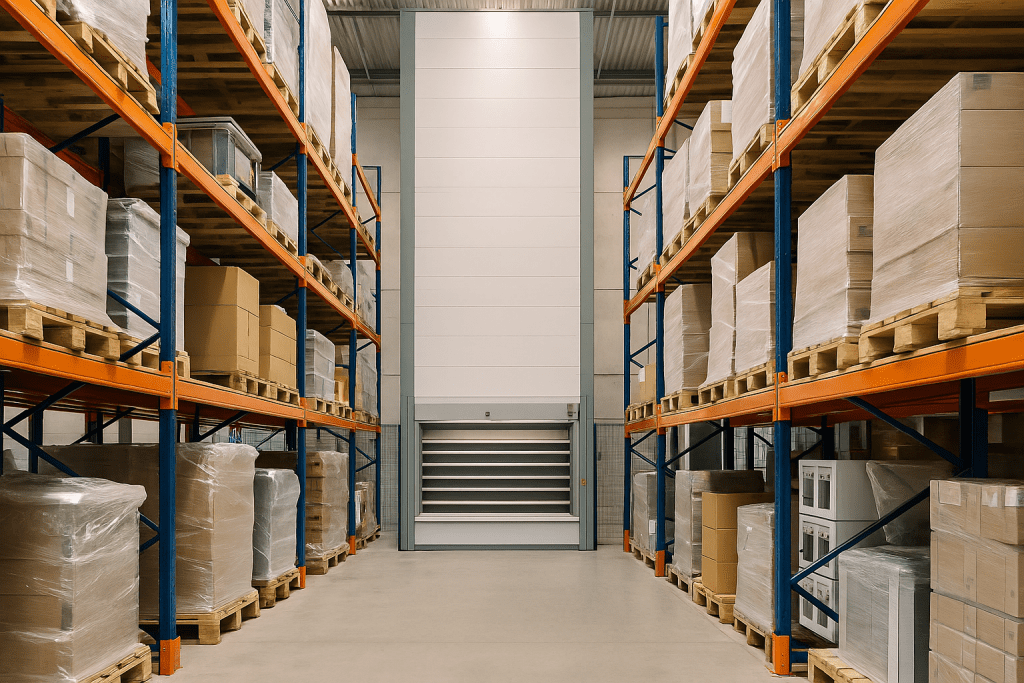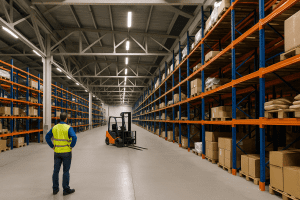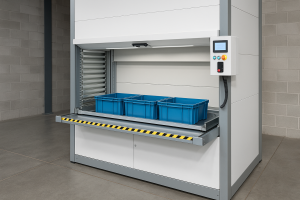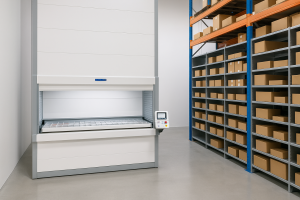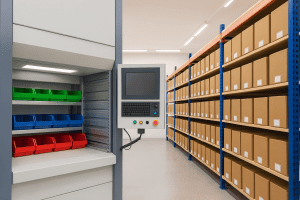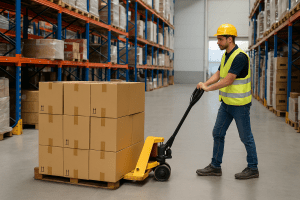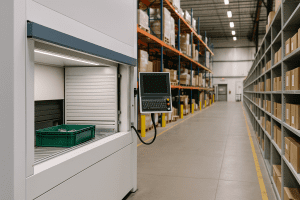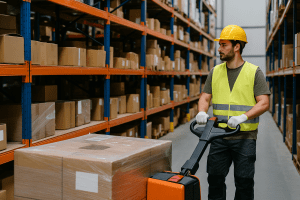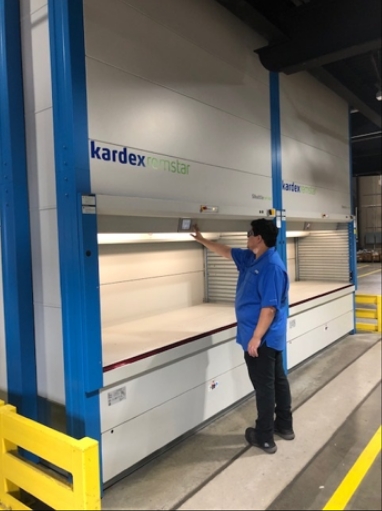This comprehensive guide walks you through how to reclaim space, streamline inventory access, and future-proof your warehouse using smart vertical storage systems and automation technology.
Step 1: Evaluate Your Current Warehouse Layout
Before introducing new systems, assess your current setup. Many warehouses operate with legacy layouts that haven’t been updated in years. Start by identifying inefficiencies such as:
Excessively wide aisles
Unused vertical space above shelving
Bottlenecks at packing or picking stations
Inventory overflow into walkways or staging areas
Tip: Walk your facility with a tape measure and sketch a rough layout. Identify where floor space is underutilized or inventory is disorganized. This visual baseline helps uncover whether you need vertical storage solutions or layout reconfiguration.
Many businesses discover they’re only using 30–50% of their available cubic space, and that’s a huge opportunity for improvement.
Step 2: Store Vertically to Maximize Capacity
One of the fastest, most cost-effective ways to gain space is to store vertically. Instead of expanding outward or leasing additional space, vertical storage taps into your facility’s unused height.
Consider these solutions:
Vertical Lift Modules (VLMs) bring items directly to the operator with automated tray delivery.
Vertical Carousel Storage Systems rotate shelves like a Ferris wheel for ergonomic picking.
Mobile Aisle Storage Systems eliminate static aisles by allowing shelving to slide side-to-side.
These systems can help you reclaim up to 90% of your floor space, allowing you to scale inventory without moving facilities.
Step 3: Implement the Right Parts Storage Solution
Efficient parts storage is essential for maintaining fast order fulfillment and minimizing errors, especially when dealing with small items or a high SKU count.
Top parts storage solutions include:
Modular drawer cabinets for compact organization
Bin shelving with clear labeling
Automated shelving systems that reduce walking and boost accuracy
Mobile aisle storage for parts rooms or back-of-house supply storage
Pro Tip: Group items by frequency of access and reorder levels. Organize fast-moving SKUs at waist level and slower movers higher up or lower down.
If you’re trying to consolidate operations or reduce travel time, pairing these systems with light-directed or barcode picking technology can yield immediate ROI.
Step 4: Optimize for Electronic Parts Storage
Warehouses in industries like aerospace, automotive, and electronics need specialized solutions for storing sensitive components. Electronic parts storage requires precision, protection, and tracking.
Must-have features:
ESD-safe trays and grounding components
Climate-controlled or sealed compartments
Access control and usage logging for traceability
These features ensure compliance with ISO standards and reduce loss from static or moisture exposure. Integrating automated solutions adds another layer of protection while increasing access speed and inventory accuracy.
Step 5: Introduce Storage Automation (Even in Small Zones)
Contrary to popular belief, you don’t need to automate your entire warehouse to reap the benefits of technology. Storage automation can begin in a single department or storage zone.
Automation options include:
Vertical Lift Modules for parts and tools
Horizontal Carousels for fast-moving SKUs
AS/RS systems for bin or tote-based storage
These systems reduce pick time, eliminate search behavior, and help you reduce picking labor by up to 70%. They’re ideal for facilities looking to do more with fewer workers in today’s tight labor market.
Step 6: Match the Storage System to Your Inventory Type
Choosing the right system depends on the shape, volume, and velocity of your inventory.
| Inventory Type | Best Storage Solution |
|---|---|
| Palletized goods | Traditional racking or bulk shelving |
| Small, slow-moving SKUs | Modular drawers or mobile aisle storage |
| Small, high-velocity SKUs | Vertical carousels or VLMs |
| Sensitive electronic parts | ESD-safe VLMs |
| High SKU density | Automated vertical storage systems |
If you’re uncertain which path is best, a free consultation can identify the right-fit approach based on your current and future needs.
Step 7: Plan for Integration, Not Overhaul
Modern storage systems are modular and designed for easy integration with existing infrastructure. You don’t have to start from scratch.
Smart integration ideas:
Install a VLM near your packing area to reduce walk time
Retrofit backroom storage with mobile aisle systems to condense parts storage
Browse used vertical storage equipment to implement automation cost-effectively
You can also phase in automation, starting with one machine or section, and then expand as your needs grow.
Step 8: Track Results and Optimize
Once your new storage solutions are in place, it’s important to measure their impact. This helps refine your systems and build a case for future investment.
Key metrics to monitor:
Storage density: Cubic feet saved
Pick accuracy: Order errors before/after
Labor reduction: Pick and put-away time
Travel time: Distance walked by operators
Return on investment (ROI): Use our ROI calculator to forecast savings
Most companies begin seeing returns within 12–24 months, especially when combining space savings with labor optimization.
Frequently Asked Questions (FAQ)
What is a warehouse storage solution?
A warehouse storage solution refers to systems and equipment designed to organize, store, and retrieve inventory efficiently. Examples include pallet racking, modular shelving, vertical lift modules (VLMs), and automated vertical storage systems.
How can I increase warehouse storage without expanding?
You can store vertically using VLMs, vertical carousels, or mobile aisle storage systems to recover up to 90% of floor space, without relocating or expanding your facility.
What is the best way to store small parts?
Use modular drawer cabinets, bin shelving, or automated solutions like vertical lift modules for high-density, fast-access storage of small items.
What if I store electronic components?
You’ll need electronic parts storage systems that offer ESD protection, climate control, and secure access to safeguard sensitive inventory.
Are automated storage systems worth it?
Yes, automated storage systems can cut pick times by 60–70%, improve accuracy, and drastically reduce space requirements. Most systems pay for themselves in 1–3 years.
Conclusion: Don’t Expand—Optimize
If you’re outgrowing your warehouse, the answer might not be more space, but it might be smarter space. With the right warehouse storage solution, you can increase capacity, reduce overhead, and boost picking performance; all without new construction.
From vertical lift modules to mobile shelving systems and automated carousel storage, there’s a scalable option to fit your operation and budget.
Ready to Upgrade?
Explore new and used VLMs or request a free quote to start reclaiming your floor space today. Our team can walk your facility and create a layout optimized for your needs.

